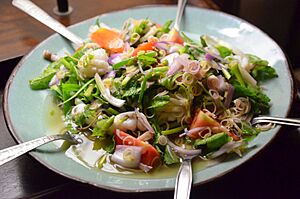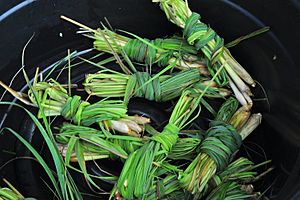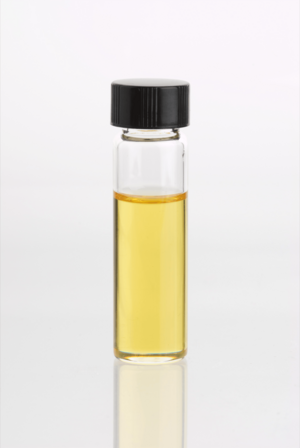Lemongrass facts for kids
Quick facts for kids Lemongrass |
|
|---|---|
 |
|
| Cymbopogon citratus | |
| Scientific classification |
|
| Kingdom: | Plantae |
| Clade: | Tracheophytes |
| Clade: | Angiosperms |
| Clade: | Monocots |
| Clade: | Commelinids |
| Order: | Poales |
| Family: | Poaceae |
| Subfamily: | Panicoideae |
| Supertribe: | Andropogonodae |
| Tribe: | Andropogoneae |
| Subtribe: | Andropogoninae |
| Genus: | Cymbopogon Spreng. |
| Type species | |
| Cymbopogon schoenanthus (L.) Spreng.
|
|
| Synonyms | |
|
|
Cymbopogon, also known as lemongrass, is a type of plant found in Asia, Africa, Australia, and many tropical islands. It belongs to the grass family.
Some kinds of lemongrass, especially Cymbopogon citratus, are grown for cooking and for their helpful properties. They have a fresh smell, much like lemons. People call them by many names, including lemon grass, barbed wire grass, citronella grass, fever grass, and tanglad.
Contents
What is Lemongrass Used For?
Lemongrass is a popular herb in Asian cooking. It is also used in traditional medicine in India. It has a light citrus taste. You can use it fresh, or dry it and grind it into a powder.

This herb is often added to teas, soups, and curries. It tastes great with chicken, fish, beef, and seafood. In countries like Togo, the Democratic Republic of the Congo, and Mexico, people often drink lemongrass as a tea.
Lemongrass Oil: More Than Just Flavor
The oil from lemongrass is used to keep bugs away, like a pesticide. It also helps keep food fresh. Scientists have found that lemongrass oil can even stop some types of fungi from growing.
Even though it can keep some insects away, like mosquitoes, lemongrass oil is also used to attract honey bees! This is because the oil smells like a special chemical that honey bees use to communicate. Beekeepers sometimes use lemongrass oil to attract bee swarms or guide bees to their hives.
Citronella Grass and Its Uses

Two types of lemongrass, Cymbopogon nardus and Cymbopogon winterianus, are known as citronella grass. They can grow up to 2 m (6.6 ft) tall and have purple-red stems at the bottom.
These plants are used to make citronella oil. This oil is found in soaps, bug sprays, and candles that help keep mosquitoes away. It is also used in aromatherapy, which uses plant scents for well-being. The main chemicals in citronella, geraniol and citronellol, help clean things. That is why they are in household cleaners and soaps. Besides making oil, citronella grass can also be used to flavor food.
Some gardeners plant citronella in their gardens to keep bugs like whitefly adults away. This helps them grow vegetables like tomatoes and broccoli without needing to use many pesticides. However, citronella roots can spread quickly, so gardeners need to be careful.
Protecting Old Manuscripts
Lemongrass oil is also used to protect very old palm-leaf manuscripts in India. These are ancient books written on dried palm leaves. The oil helps keep the manuscripts from getting damaged by moisture. It also makes the brittle leaves more flexible so they don't break easily. Many places, like the Oriental Research Institute Mysore, use this oil to preserve these important historical documents.
Different Kinds of Lemongrass
There are different types of lemongrass. East Indian lemongrass (Cymbopogon flexuosus) grows naturally in countries like Cambodia, Vietnam, Laos, India, Sri Lanka, Burma, and Thailand. West Indian lemongrass (Cymbopogon citratus) comes from South Asia and parts of Southeast Asia.
Both types can be used for similar things, but C. citratus is usually better for cooking. In India, C. citratus is used for both medicine and perfumes. Lemongrass is also added to teas and traditional herbal drinks like kadha, which is part of Ayurvedic medicine.
Images for kids
See also
 In Spanish: Hierba de limón para niños
In Spanish: Hierba de limón para niños






